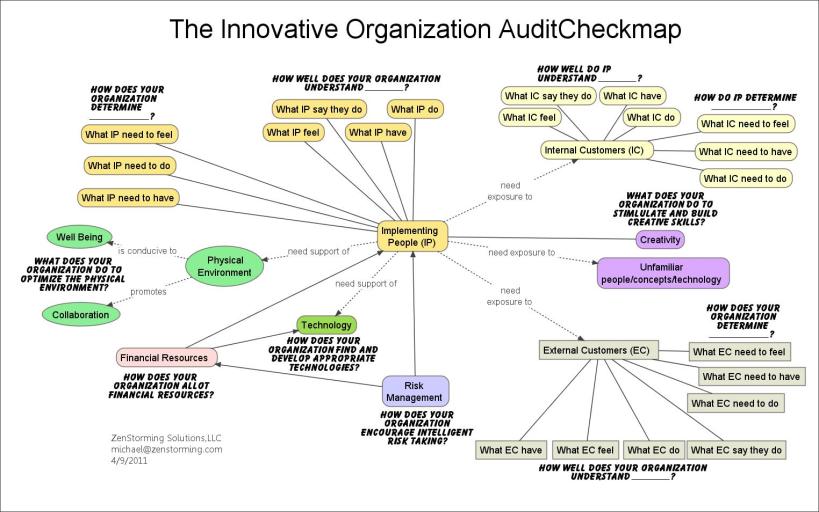I put together this Innovation Checkmap. It highlights the working relationships that should be present in healthy, innovative organizations; a visual checklist to guide an audit of the innovation capabilities in your organization. The map is simple to use:
- Pick a group (and/or individuals) as your Implementing People (IP).
- Walk your way around the map asking the questions in bold with reference to your IP.
- Repeat steps 1-2 for every entity in the organization.
If you can’t really answer a question, it shows that your organization is most likely weak in that area. Make sure that you actually have data of some type to back up your answers. If all you have are your opinions, (as in, “Those people don’t need to have access to the order system. Why would they?”) that’s a problem.
Some definitions are in order.
Implementing People (IP) – This represents anyone (or group) that is doing a task, whether it’s people in the C-Suite, Finance, R&D, Operations, etc.. It’s intentionally vague but it’s put at the center of the map as it is the starting point for an innovation audit. Pick a group you want to analyze and they are your IP.
Internal Customers (IC) – These are people the IP interact with on a regular basis. This can include stakeholders.
External Customers (EC) – These are your customers, users, patients, clients. They are people or organizations that are not part of your organization. They are people you serve or provide products to.
Each group has needs. They’ve been broken down into, ‘What they need to feel,’ What they need to do,’ ‘What they need to have.” These are distinguished from what they actually feel, do, and have. The phrase, “How does your organization determine ‘what IP need to feel’?” means, “How does the organization determine the affective needs of the IP?” For example, individuals in a certain group may need to feel wanted, feel pride, feel challenged, etc. Also, disconnects between what people need to feel and what they are actually feeling, or what they need to have and what they actually have, are signs that something is amiss.
I’ve also included a question regarding understanding what people say they do in addition to what they are actually doing. If these aren’t the same, that’s an issue.
Another way to look at this map is as a source of metrics for gauging your innovation effectiveness. Traditionally, most metrics are in the financial realm (ROI, Gross Profits, etc.) with a few from the Creativity side (Number of patents, etc.). Push your organization to have metrics of some type for each node/question in this map.
This chart can also be used as a culture change guide. Changing how nodes work and the relationships will impact your culture.
Any questions or comments are welcome!





This post is very good becasue it asks the simplest of questions. What do ____need to feel, have and do. The map is awesome!